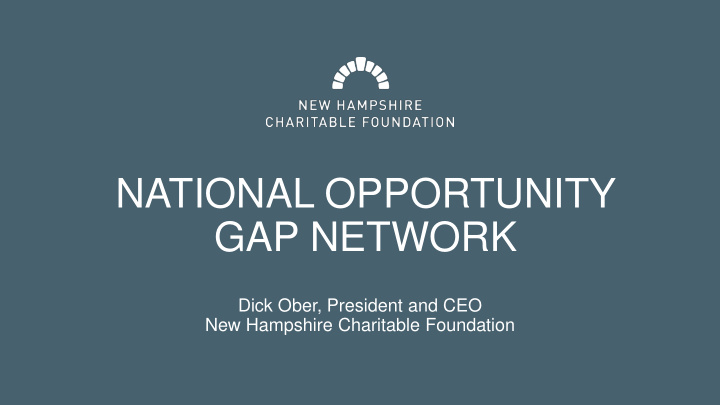



NATIONAL OPPORTUNITY GAP NETWORK Dick Ober, President and CEO New Hampshire Charitable Foundation
WHAT IS THE OPPORTUNITY GAP? “The central tenet of the American Dream — that all children, regardless of their family and social background, should have a decent chance to improve their lot in life — is no longer self evident.”
EVIDENCE OF THE OPPORTUNITY GAP Kids with lower income / less-educated parents are less likely to… • Have two parents at home • Go to preschool • Engage in sports, music, other enrichment • Attend church, synagogue, mosque • Spend as much time talking to parents • Finish college
THE GROWING GAP IN INCOME Median Income by Quintile $100,000 Q5 United States $90,000 New Hampshire $80,000 $70,000 $60,000 Q4 $50,000 $40,000 Q3 $30,000 $20,000 Q2 $10,000 Q1 $0 1960 1970 1980 1990 2000 2012 Note: 2010 data are from the 2008-2012 American Community Survey 5-Year Estimates Note: Medians and quintiles calculated using all people with income Note: Income is only asked of “sample - line” persons in 1950 making estimates of household income unreliable
THE GROWING GAP IN PARENT EDUCATION AND MARITAL STATUS Percent of Children in Single Parent Families by Parent’s Highest Level of Education 80% NH High school or less 70% NH Bachelor's or more 60% US High school or less US Bachelor's or more 50% 40% 30% 20% 10% 0% 1950 1960 1970 1980 1990 2000 2010 Note: Sample size is too small to provide a reliable estimate for bachelor’s or more in New Hampshire in 1950, 1960, and 197 0 Note: 2010 data are from the 2008-2012 American Community Survey 5-Year Estimates
GROWING GAP IN ACADEMIC ACHIEVEMENT BY INCOME 8th Grade Achievement in Math by School Income 852 850 Students Without Subsidized Lunch 848 Students With Subsidized Lunch 846 Average NECAP Score 844 842 840 838 836 834 832 830 Bottom 10% Middle 50% Top 10% School Districts Grouped by Income in District Source: Average 2011-2012 8 th Grade Math Achievement, NECAP. School districts grouped by the percent of students eligible for Free and Reduced Lunch.
GROWING GAP IN B.A. ATTAINMENT BY FAMILY INCOME 35% Q4 Across income quartiles, college education is increasingly 30% common in both NH and the nation. However, the increase is greatest for the top quartile and the gap between the top and third quartiles has increased. 25% Q3 20% Percent New Hampshire Q2 15% United States Q1 10% 5% 0% 1950 1960 1970 1980 1990 2000 2010 Note : 2010 data are from the 2008-2012 American Community Survey 5-Year Estimates
CARSEY INSTITUTE: DATA FOR YOUR STATE To find opportunity gap data for your state visit: https://carsey.unh.edu/policy/gaps-in-youth-opportunity-by-state/
FROM INFORMATION TO ACTION WHAT’S JULY 2015 FALL 2015 FEB 2015 NEXT? CEO Putnam: Steering “Community Gathering: Committee White Papers: Explore Foundations Volunteers 5 Solutions National are the civic begin to Define Opportunity backbone of collaborate deliverables the US” – Gap Network Network and strategies uniquely begun positioned to narrow gaps
WHITE PAPERS: 5 CHAPTERS - 5 SOLUTIONS • Promote Stable Families and Effective Parents • Promote Opportunity in Early Childhood • Increase Equality of Opportunity K – 12, in and out of school • Rebuild Communities to Help Close the Opportunity Gap • On-Ramps for Success
OPPORTUNITY GAP NETWORK: INITIAL MEMBERS STEERING COMMITTEE MEMBERS: Boston Arizona Columbus Atlanta Dayton Carolinas Dubuque Chicago Maine Hartford Milwaukee New Haven New Hampshire Pittsburgh Omaha Tulsa Seattle Vermont Duluth
OPPORTUNITY GAP NETWORK: PARTICIPATION CRITERIA • See opportunity gap as framework for action • Positioned to drive meaningful collective action • Open to learning and sharing with others • Committed to collective advocacy • Willingness to contribute financially
OPPORTUNITY GAP NETWORK: DELIVERABLES – FIRST CUT • Establish community foundations as a national voice on the OG • Use white papers as frame for solutions • Establish a shared repository of common activities • Demonstrate improvement in policy structure • Establish mechanisms for tracking data on the opportunity gap • Identify partners on the local and national level
OPPORTUNITY GAP NETWORK: STRATEGIES • Learn from promising “experiments” on the ground • Intentional search for alignment with federal priorities • Engage universities, think tanks and other research and program partners • Determine best approaches for tracking data and impact • Create peer networks across CFs on OG issues (beyond CEOs) • Engage donors around the OG work • Leverage community/civic engagement practices already in place • Explore collaborations: • PBS documentary, Urban Institute & Gates, Ford Foundation, etc.
NEXT STEPS • Steering Committee meeting Friday • Putnam role • Backbone or stand-alone? • COF Conference in April
OPPORTUNITY GAP NETWORK: FUNDING STRUCTURE Minimum suggested contribution: Foundation Assets Min. Contribution 2 years $1 Billion $10,000 per year $500M - $1Billion $5,000 per year < $500 Million $2,500 per year
Recommend
More recommend